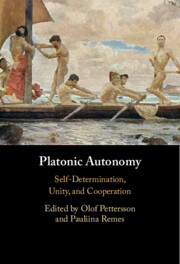Book contents
- Platonic Autonomy
- Platonic Autonomy
- Copyright page
- Contents
- Tables
- Contributors
- Acknowledgements
- Abbreviations
- Introduction
- Part I Self-Determination
- Part II Motivational Challenges to Self-Rule
- Chapter 2 Plato’s Problems with Aversion
- Chapter 3 A Complex Model of Action: What Is Ruling?
- Part III Internal and External Authorities
- Part IV The Limits of Autonomy and Self-Rule
- Part V Reconciling between Freedom, External Authority, and Nature
- Bibliography
- Index
Chapter 2 - Plato’s Problems with Aversion
from Part II - Motivational Challenges to Self-Rule
Published online by Cambridge University Press: 07 August 2025
- Platonic Autonomy
- Platonic Autonomy
- Copyright page
- Contents
- Tables
- Contributors
- Acknowledgements
- Abbreviations
- Introduction
- Part I Self-Determination
- Part II Motivational Challenges to Self-Rule
- Chapter 2 Plato’s Problems with Aversion
- Chapter 3 A Complex Model of Action: What Is Ruling?
- Part III Internal and External Authorities
- Part IV The Limits of Autonomy and Self-Rule
- Part V Reconciling between Freedom, External Authority, and Nature
- Bibliography
- Index
Summary
In his Republic, Plato claims that we always do whatever we do in pursuit of the good. But in Book IV of the Republic, Plato shows that people can have attractions and aversive reactions at the same time toward the same objects or actions. In this essay, I argue that Plato’s recognition and use of aversion as a motivating response cannot be squared with what I call his ‘motivational monism’, that is, with the view that the pursuit of the good is the only thing that motivates us. Rather, as Plato’s own arguments show clearly, sometimes we don’t pursue what is good; instead, we act so as to avoid what is bad. I contend that this negative motivation cannot be wholly understood in terms of our positive interest in what is good.
Information
- Type
- Chapter
- Information
- Platonic AutonomySelf-Determination, Unity, and Cooperation, pp. 45 - 57Publisher: Cambridge University PressPrint publication year: 2025
Accessibility standard: WCAG 2.1 AA
Why this information is here
This section outlines the accessibility features of this content - including support for screen readers, full keyboard navigation and high-contrast display options. This may not be relevant for you.Accessibility Information
Content Navigation
Allows you to navigate directly to chapters, sections, or non‐text items through a linked table of contents, reducing the need for extensive scrolling.
Provides an interactive index, letting you go straight to where a term or subject appears in the text without manual searching.
Reading Order & Textual Equivalents
You will encounter all content (including footnotes, captions, etc.) in a clear, sequential flow, making it easier to follow with assistive tools like screen readers.
You get concise descriptions (for images, charts, or media clips), ensuring you do not miss crucial information when visual or audio elements are not accessible.
Visual Accessibility
You will still understand key ideas or prompts without relying solely on colour, which is especially helpful if you have colour vision deficiencies.
Structural and Technical Features
You gain clarity from ARIA (Accessible Rich Internet Applications) roles and attributes, as they help assistive technologies interpret how each part of the content functions.
